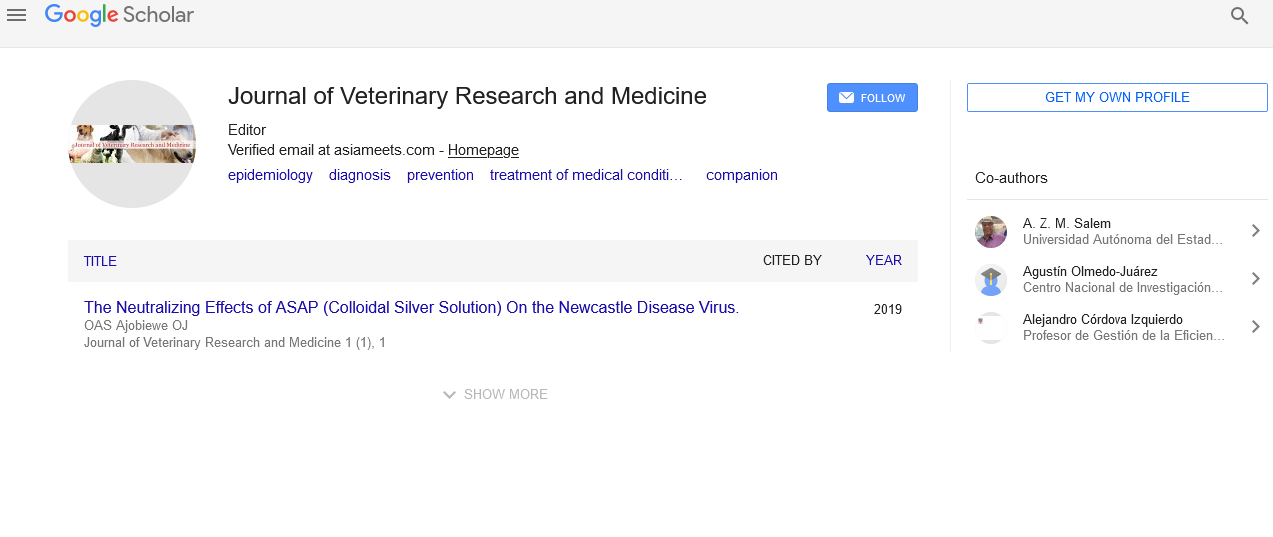Animal diagnosis methods
Received: 04-Oct-2021 Accepted Date: Oct 18, 2021; Published: 25-Oct-2021
Citation: Buij J. Animal diagnosis methods. J Vet Res Med 2021;3(2):4.
This open-access article is distributed under the terms of the Creative Commons Attribution Non-Commercial License (CC BY-NC) (http://creativecommons.org/licenses/by-nc/4.0/), which permits reuse, distribution and reproduction of the article, provided that the original work is properly cited and the reuse is restricted to noncommercial purposes. For commercial reuse, contact reprints@pulsus.com
Description
Before an unhealthy animal gets treatment, an attempt is made to diagnose the disease. Both medical findings and laboratory test results are crucial to set up the cause of sickness. A medical examination must imply if the animal is in an abnormal physical condition, is consuming adequately, is bright and alert, and is functioning in a ordinary manner. Many disorder methods are either inflammatory or result from tumors. Malignant tumors have a tendency to spread rapidly and typically cause death. Other illnesses cause circulatory disturbances or degenerative and infiltrative changes. If a specific diagnosis isn't possible, the signs of the animal are treated.
Diagnosis consists of a description of the animal (age, species, sex, breed); the owner’s report; the animal’s history; a description of the initial examination; medical findings resulting from an examination of body systems; outcomes of particular laboratory tests; diagnosis regarding a particular cause for the disease (etiology); outlook (prognosis); treatment; case progress; termination; autopsy, if performed; and the usage of scientific references, if applicable.
The veterinarian should diagnose disease on the basis of a number of examinations and tests, considering that he obviously cannot interrogate the animal. Methods used in the practice of a diagnosis consist of inspection-a visual examination of the animal; palpation-the application of firm pressure with the fingers to tissues to decide characteristics inclusive of ordinary shapes and possible tumors, the presence of pain, and tissue consistency; percussion-the application of a short, sharp blow to tissue to initiate an audible reaction from body components directly beneath; auscultation-the act of paying attention to sounds which might be produced through the body during the overall performance of functions (e.g., respiration, intestinal movements); smells-the recognition of characteristic odors associated with certain sicknesses; and miscellaneous diagnostic procedures, including eye examinations, the gathering of urine, and heart, esophageal, and stomach studies. The standard inspection consists of an examination of appearance; behavior; body condition; breathing actions; the state of skin, coat, and stomach; and numerous common actions.
The respiratory actions of an animal are crucial diagnostic criteria; respiration is fast in young animals, in small animals, and in animals whose body temperature is better than regular. Specific respiratory actions are a function of certain diseases. The appearance of the skin and hair might also additionally indicate dehydration through lack of pliability and luster; or the presence of parasites inclusive of lice, mites, or fleas; or the presence of ringworm infections and allergies through the skin changes they cause.
Abnormal activities may have special diagnostic meaning to the veterinarian. Straining during urination is associated with bladder stones; increased frequency of urination is related to kidney disorder (nephritis), bladder infections, and a disorder of the pituitary gland (diabetes insipidus). Excessive salivation and grinding of teeth can be caused by an abnormality in the mouth. Coughing is related to pneumonia. Some diseases cause postural changes: for example, a horse with tetanus might also additionally stand in a stiff manner.





